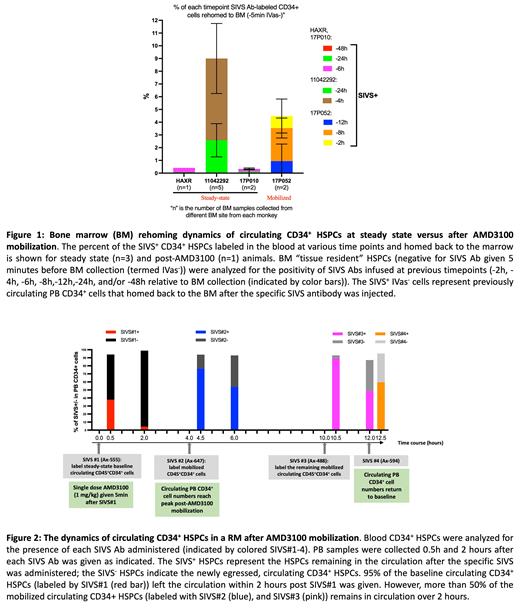The safety and efficacy of hematopoietic stem and progenitor cell (HSPC) allogeneic transplantation and autologous gene therapies are dependent on mobilization of HSPCs out of bone marrow (BM) niches into peripheral blood (PB) and homing of infused HSPCs into open niches. However, the disposition of HSPCs exiting the marrow in steady state and following mobilization are not well understood. We characterized short-term (≤ 48 hours (h)) HSPC dynamics during steady state and following mobilization (single dose AMD3100 (plerixafor), 1mg/kg) in rhesus macaques (RMs), a model with direct preclinical relevance.
We used serial intravascular staining (SIVS) (Potter et al., 2021; Morlock et al., 2021), based on timed intravenous infusions of multiple fluorescently labeled anti-CD45 antibodies (Ab) (half-life ~8.5 min), to specifically and instantaneously label all blood leukocytes at the time of each infusion, providing a window into blood residence time and tissue entry and egress. SIVS Abs are stably retained on the surface of leukocytes for up to one week and persist with migration into tissues, allowing determination of the passage of cells in and out of circulation. SIVS Abs were administered at multiple time points over 48 h, and PB was collected 5 (minutes (min)) before and 5 min, 2 h, and 4 h after each infusion. PB and BM were collected 5 min after the final Ab infusion, which was used to designate cells as intravascular (-5 min +/IVas +) or tissue-homed (-5 min -/IVas -). HSPC subsets and SIVS Abs were analyzed via flow cytometry. Additionally, trafficking to extramedullary HSPC tissue reservoirs (spleen, thymus, lymph nodes) was studied in a RM euthanized immediately following the final Ab infusion.
Under steady state (n=3 RMs), we documented rapid (≤ 2 h) homing of ~55-95% of blood HSPCs out of the circulation to alternate tissue reservoirs. Of the circulating HSPC subsets, no significant differences were observed between the trafficking of HSC-enriched (CD34 +CD45RA -CD90 +), lympho-myeloid progenitor-enriched (CD34 +CD45RA +CD90-), and multipotent and erythro-myeloid progenitor-enriched (CD34 +CD45RA -CD90 -) HSPCs (Radtke et al., 2020). Following 48 h, minimal (≤ 10%) circulating HSPCs from all earlier times were found in BM, suggesting that steady state circulating HSPCs rarely “rehome,” at least within 48 h (Figure 1). Of the extramedullary reservoirs studied, minimal HSPCs trafficked to the thymus or lymph nodes; however, the spleen had a population (< 14 %) of HSPCs moving in and out over a 24 h period.
To investigate the impact of AMD3100 on HSPC trafficking (n=1 RM), four SIVS Abs were administered 5 min prior to mobilization (baseline), at peak of mobilization (4 h post-AMD3100), and 10 h and 12 h post-AMD3100, as the concentration of blood HSPCs decreased. PB was collected 5 min before and 5 min, 0.5 h, and 2 h post each SIVS Ab infusion to monitor HSPC kinetics; PB and BM were collected at 12 h post-AMD3100, and final PB was collected at 24 h post-AMD3100. Compared to steady state HSPC dynamics described above, mobilized HSPCs labeled at the peak of mobilization exhibited prolonged circulation (Figure 2), with a higher portion of the mobilized cells remaining in the blood at the 2 h time window compared to steady state. However, there was no increase in the fraction of the HSPCs rehoming to the BM (Figure 1), suggesting that mobilized HSPCs do not exhibit a greater propensity for rehoming compared to steady state and that BM niches are still open 12 h after mobilization. The extended availability of these niches holds potential relevance for the use of potent mobilizing regimens to facilitate engraftment of transplanted autologous gene-modified or allogeneic HSPCs.
In summary, under both steady-state and mobilization conditions, HSPCs exhibit minimal rehoming to bone marrow niches, and mobilized HSPCs linger in circulation for up to 24 h post-mobilization. Further studies in progress aim to investigate longer term BM rehoming and better define extramedullary sites of HSPC egress at steady state or following mobilization. Harnessing knowledge of HSPC dynamics holds potential to improve mobilization approaches and provide key insights into developing efficient mobilization-based conditioning for safer HSPC transplantation.
Disclosures
No relevant conflicts of interest to declare.


This feature is available to Subscribers Only
Sign In or Create an Account Close Modal